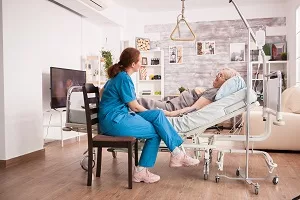When you place a loved one in a nursing home, you expect a certain standard of care. After all, you are entrusting the nursing home with your loved one’s well-being. Nurses, orderlies, and others will be taking care of this person 24 hours a day; you expect your loved one to be watched carefully and treated with respect and kindness.
Unfortunately, all too often the true picture is different. With staff shortages, lack of oversight, and lax hiring practices, too many nursing homes are filled with people who might neglect or even harm a resident. This results in some tragic cases of abuse, injury, and even death for innocent victims.
Nursing Home Falls
One startling statistic brings this problem to light: a study published by the National Institutes of Health estimates that, of all falls in nursing homes, only about half are reported to authorities or family members. Additionally, other studies found:
- As many as 75 percent of all nursing home residents experience some type of fall each year. While older people living outside nursing homes experience falls at a much higher rate than the younger population, nursing home residents are more than twice as likely to fall than older adults who do not live in nursing homes.
- Falls in nursing homes lead to roughly 1,800 deaths every year. While only five percent of adults over the age of 65 live in nursing homes, falls account for about one in every five deaths in this group.
- Falls in nursing homes are often not one-time occurrences. In fact, those who fall in a nursing home in any given year have a 33 percent chance of falling more than once.
- About 10 percent of all nursing home falls result in serious injury or death. Around six percent of all falls result in bone fractures.
- Some nursing homes record at least one fall per resident during a calendar year. Because of underreporting, experts believe this number is much higher. The average range of reported falls is 2.6 per person per year.
- About a quarter of all nursing home falls are caused by tripping hazards, such as equipment left in hallways, damaged flooring, different-level steps, and slippery surfaces. Another 35 percent of all injuries are caused by failure to assist residents who cannot walk unaided.
What Can I Do To Help My Loved One?
These statistics are sobering in view of the fact that so many people rely on nursing homes to provide care for their loved ones that they cannot give themselves. It is important to remember that there are things you can do to help and protect your loved one.
- Be sure that you examine a nursing home thoroughly before deciding to place your loved one there. If possible, get recommendations from the families of current or former residents.
- Ask questions. Any reputable nursing home should employ staff who are happy to talk to you and answer your questions when necessary. If you are not satisfied with the answers, arrange a meeting to discuss your concerns.
- Visit your loved one often. One of the best ways to see for yourself how the nursing home operates is to visit often. It may not be possible to arrange visits during certain times, but whenever you can, show up to see how things are going. This will give you a good idea of what happens when you are not there. Also, if your loved one is capable of expressing his or her thoughts, be sure to talk about the treatment given in the nursing home and how the patient feels about it.
If your loved one is injured in a nursing home, help is available. The attorneys at Barber & Associates will work with you to recover compensation for your loved one’s injuries and hold nursing homes accountable for neglect. Give us a call today to learn more.
